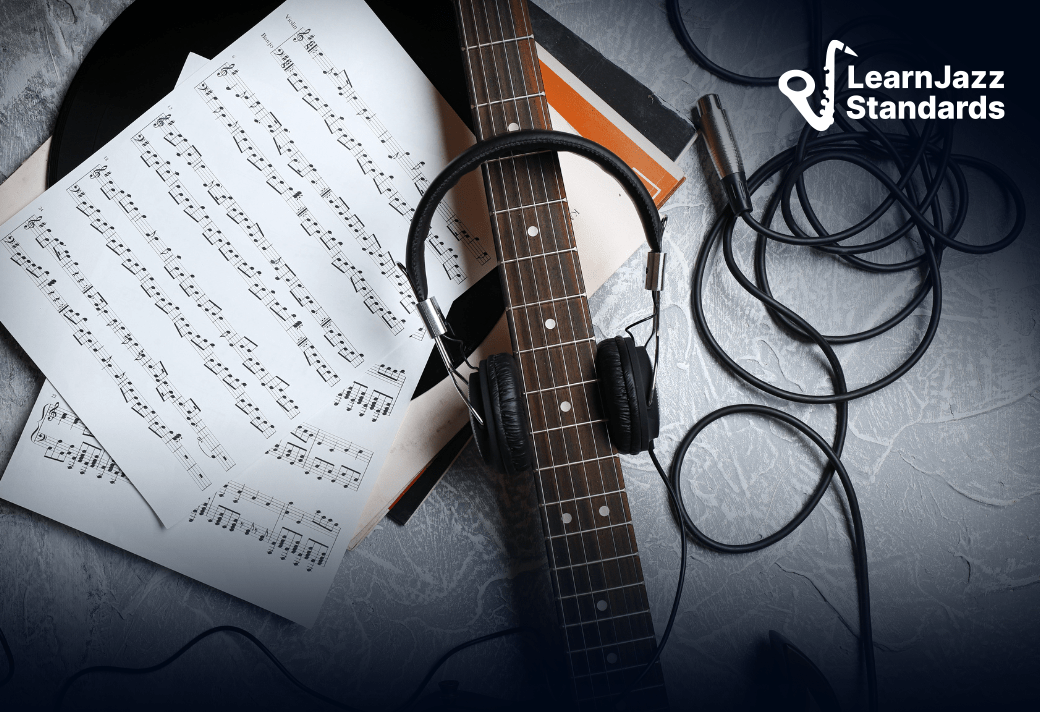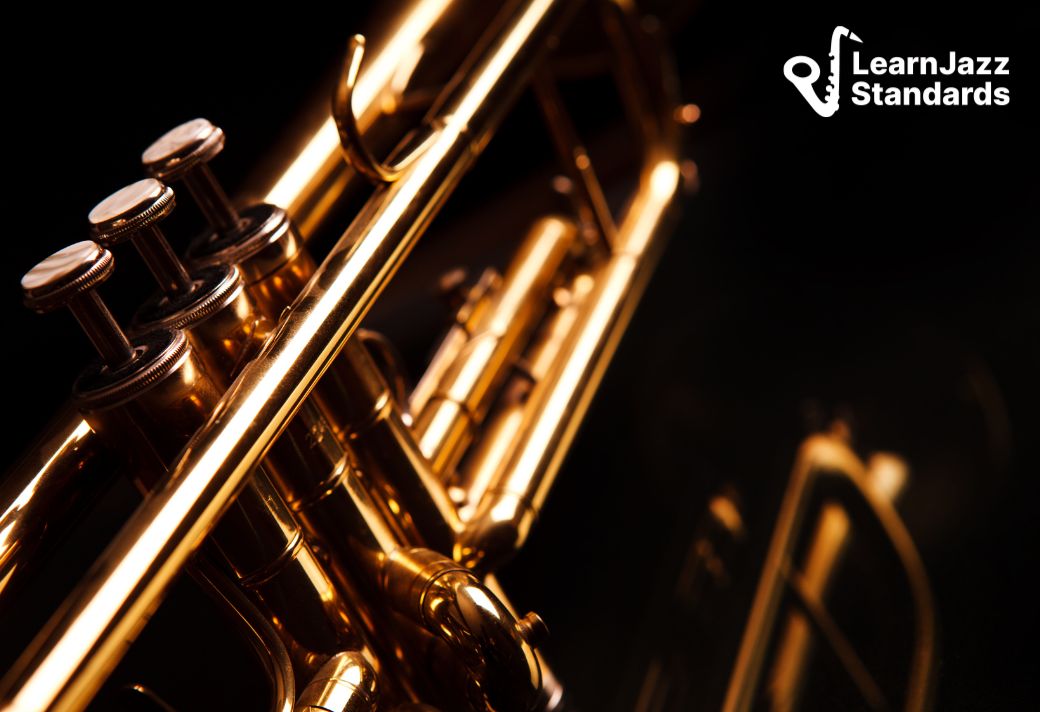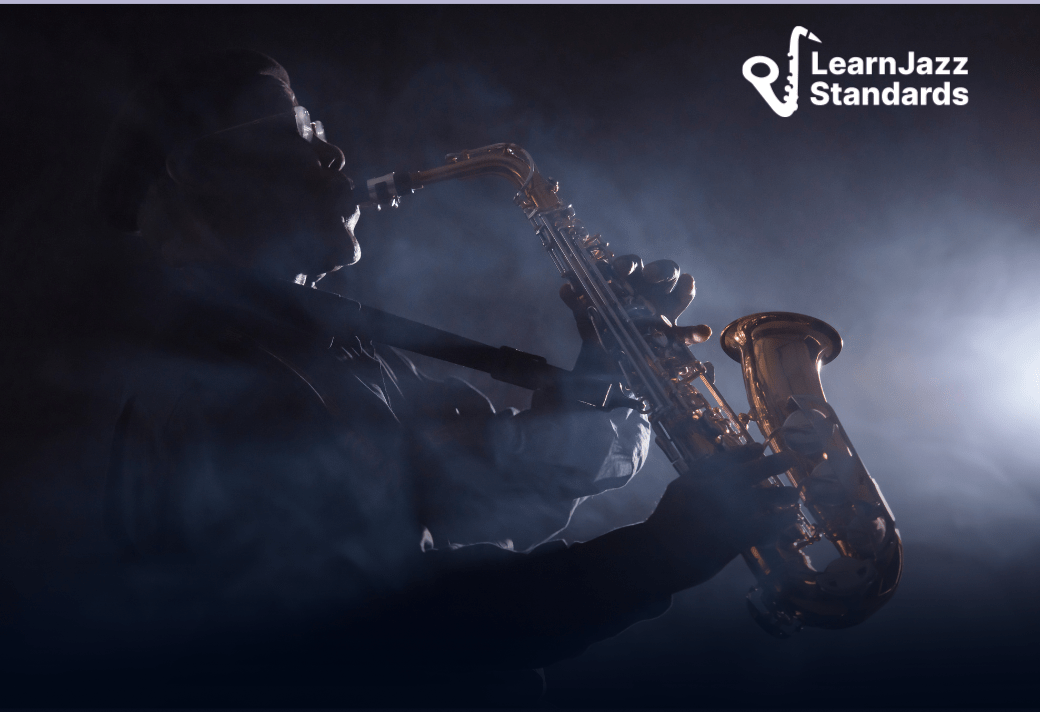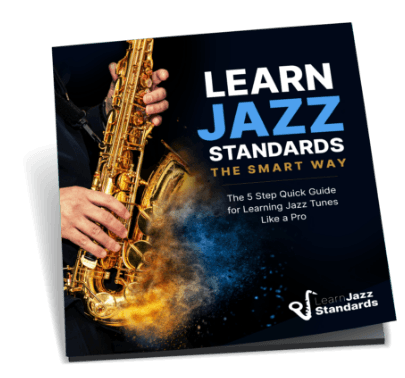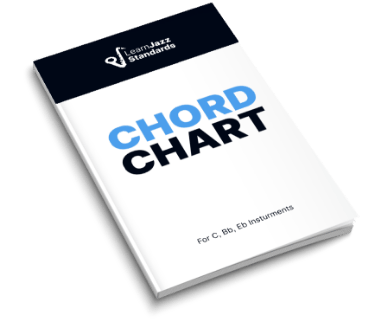If you want to be the best jazz player you can be, you need to understand jazz turnarounds. Even non-chordal saxophone and trumpet players need to know about different jazz turnarounds to navigate these chord progressions when improvising over jazz songs!
We’re about to embark on a journey that will help you understand and recognize jazz turnarounds in the wild! Whether you play a chordal instrument like guitar or piano or a monophonic instrument, like trumpet or trombone, you need to recognize these crucial jazz chord progressions while playing.
That’s why we’ll discuss—
- Important music theory you need to know before tackling jazz turnarounds
- Defining exactly what a turnaround progression is in music
- Exploring common and popular turnaround progressions
- Different ways to practice jazz turnarounds
If you are searching for info on jazz turnarounds, you likely want to improve your jazz playing and theory skills. The Learn Jazz Standards Inner Circle is an incredible jazz community that helps players like you become the best jazz musicians you can be!
Want to Improve in 30 Days or Less? Join the Inner Circle.
Table of Contents
Terms and Concepts You Need To Know To Understand Jazz Turnarounds
Before defining and exploring jazz turnarounds, let’s review some important information. This may be a review, but if you are new to jazz (and jazz chord progressions specifically), you shouldn’t skip this section!
In this article, we’ll discuss jazz chord progressions and refer to chords based on their relationship to the tonic chord of a key. If you need help understanding diatonic chords and the Roman numerals musicians use to identify them, check out this article on diatonic chords.
Here is a quick rundown. First, we’ll discuss where diatonic chords come from; then, we’ll talk about Roman numerals and how jazz musicians use them. Trust me, this is important for understanding jazz turnarounds, so I don’t want to skip anything!
Diatonic Chords
Western harmony (chord progressions) is derived from harmonized major and minor scales. Using the notes from a scale, musicians construct chords by stacking thirds from each scale degree.
For example, in the major scale, there are seven notes. Here is the C major scale:

If we stack thirds on each note in the scale, using only the notes from the scale to do so, we end up with all the diatonic chords that can be derived from that scale. There are seven notes, so we end up with seven chords. These are the seven diatonic chords in the key of C major:

Regarding Roman Numerals
Roman numerals help musicians identify the function of a chord in a chord progression. These Roman numerals are based on the scale degrees of the major scale (or natural minor). Uppercase Roman numerals denote major chords, and lowercase Roman numerals denote minor chords.
Here are the diatonic chords in C major labeled with their corresponding Roman numerals:

Jazz musicians often refer to common jazz chord progressions by their Roman numerals. If you’ve heard of the famous ii-V-I progression, this is what jazz musicians are referring to! Here is a ii-V-I chord progression in C major:

When learning about different jazz turnarounds, we’ll refer to them by their Roman numeral progression names.
Here is what we know so far:
Diatonic chords are built from the major scale, and each diatonic chord is assigned a Roman numeral based on its distance from I or the tonic chord. Diatonic chords are combined to create chord progressions, and jazz musicians use Roman numerals to organize and label these chord progressions.
Now, we are ready to learn about jazz turnarounds!
Check out these articles for more information on seventh chords and jazz chord progressions. Check out this article to learn about the ii-V-I progression specifically.
What Is A Turnaround Progression?

image source: Wikimedia Commons
Simply put, a jazz turnaround progression is a chord progression.
They are often two measures long and have a harmonic rhythm of four chords (one every two beats). Turnarounds lead the progression back to a target chord. Usually, this target chord is the tonic chord (or I chord), but turnarounds can also lead to tonic chords in different keys or even non-tonic chords.
Jazz turnarounds are found at the end of sections and help lead the listener back to the beginning or a new section of the song.
For example, a turnaround progression is often played at the end of the blues form to lead back to the beginning of the form. However, you can also find them in the middle of a form because they can bridge sections together, leading from an A to a B through a turnaround progression.
Here is a turnaround progression at the end of a jazz blues. Notice how it is two bars long and sets us up to go back to the I (the last chord in the turnaround progression is a V chord, so we expect it to resolve to the I chord).

Check out this article to learn more about blues chord progressions.
Here are common changes to the jazz standard “Misty.” Notice the turnaround progression at the end of the first section! The chord progression leads back to the second A.
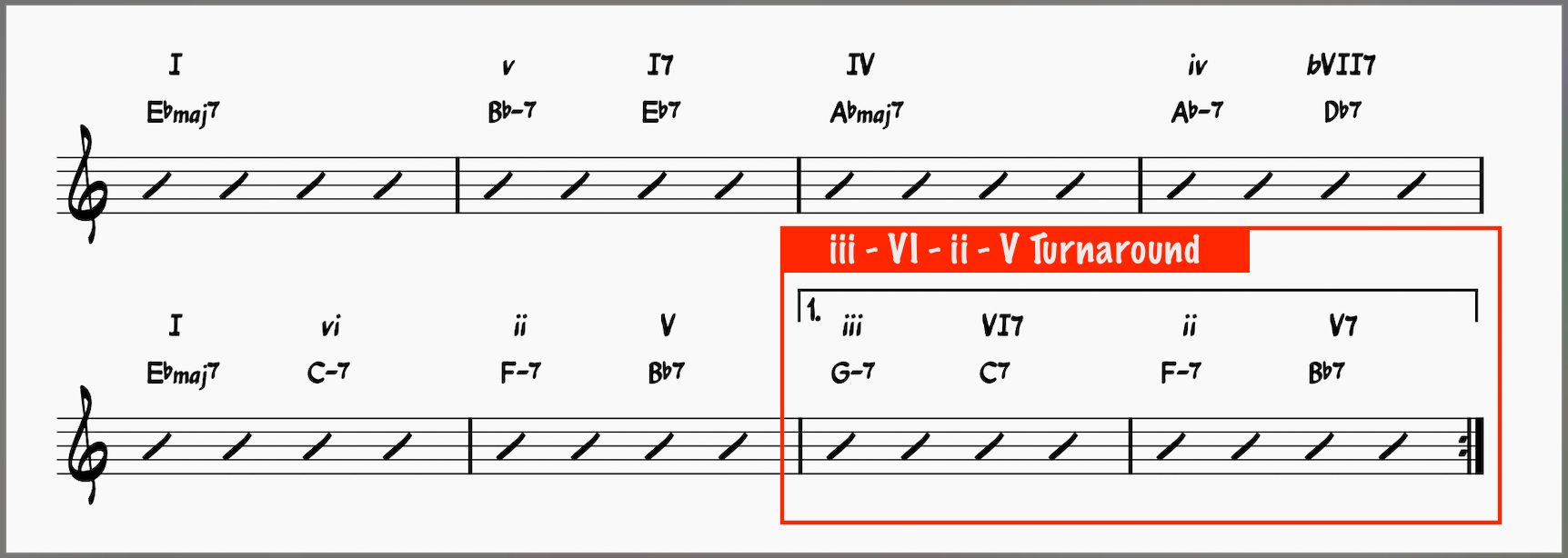
Check out this article to learn more about the “Misty” chords.
Secondary Dominants and Chord Substitutions in Jazz Turnarounds
Being chord progressions, turnarounds can include substituted chords. Many turnaround progressions do contain at least one chord substitution. It’s important to talk about some chord substitutions before getting into examples that feature them!
Some of you may have noticed that the previous example contained non-diatonic chords. Misty is in Eb, but we see minor chords labeled v and iv, and dominant chords labeled I7, VI7, and bVII7. Some of these non-diatonic dominant chords are secondary dominants.
Secondary Dominants
We need to talk briefly about secondary dominants because many of the jazz turnarounds we are about to discuss contain them, including the iii-VI-ii-V in the example above.
Secondary dominants are dominant chords that resolve to non-tonic chords. In other words, they are V7-I or V7-i cadences in a progression that do not resolve to I. Many jazz chord progressions contain secondary dominants, which are a kind of chord substitution.
Secondary dominant chords are sometimes called “V of… ” chords. For example, the Eb7 that resolves to Abmaj7 in Misty is the “V of IV.” In our “Misty” turnaround, the C7 that resolves to F-7 is the “V of ii.”
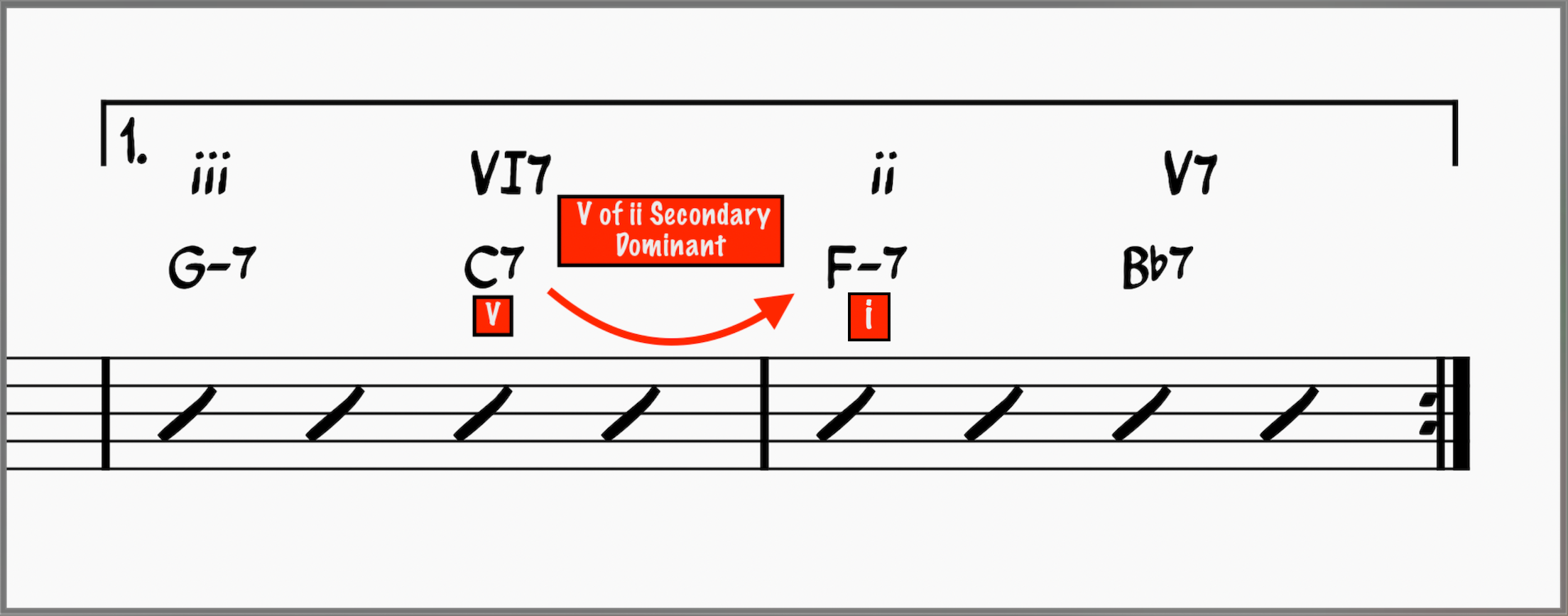
Bar four’s iv – bVII7 progression doesn’t contain a secondary dominant. Instead, this is an example of a “backdoor ii-V,” which resolves up a whole step to the tonic.
Check out this article for more on secondary dominant chord substitutions. Check this one out for more on the backdoor progression.
Tritone Substitutions
The tritone substitution is another chord substitution jazz musicians employ in their playing. Tritone substitutions often replace dominant chords with another dominant chord a tritone away.
Tritone substitutions have the same guide tones as the dominant chords they replace (see below in red). Also, when using tritone substitution, you get chromatic movement from the ii to the bII7 resolving to the I (see below in blue).

Check out this article for more information on tritone substitution.
Diminished Chord Substitutions
Finally, you’ll find diminished chords in many jazz turnarounds. Diminished chord substitutions have a few functions in chord progressions. Usually, they serve as chromatic passing chords or approach chords. Alternatively, they can function as substitutions for dominant chords.
In some of our turnaround examples, we’ll see diminished chords used as chromatic approach and chromatic passing chords.
Here is a turnaround progression that uses a biii°7 chord. It shares half its notes with the D-7 chord that comes after it (A and C). The other two notes of the Eb°7 chord resolve down a half step (Gb to F and Eb to D).

Check out this article for more on diminished chords.
BEFORE YOU CONTINUE...
If music theory has always seemed confusing to you and you wish someone would make it feel simple, our free guide will help you unlock jazz theory secrets.
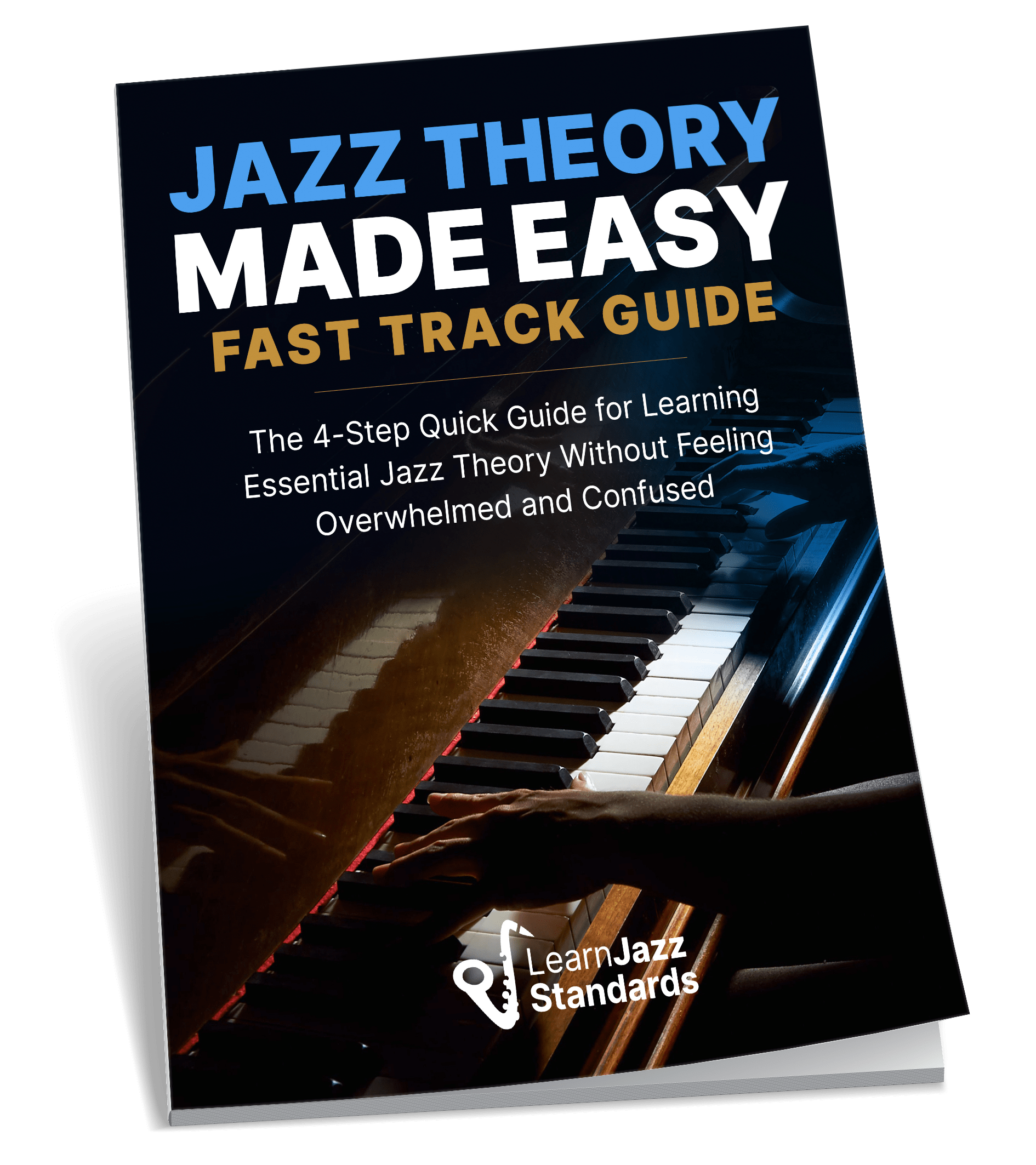
12 Common Jazz Turnarounds
We’ve thoroughly discussed what jazz turnarounds are and went over different chord substitutions you are likely to find in them. Now, we can tackle common jazz turnaround progressions you will likely find on your jazz journey!
For the following examples, we’ll start with a basic I-vi-ii-V and evolve our turnaround progression as we move along. Be sure to listen to the audio files included in this article!
1. I–vi–ii–V
Our first turnaround progression is entirely diatonic. There are no borrowed chords or chord substitutions.

- I chord: Cmaj7
- vi chord: A-7
- ii chord: D-7
- V chord: G7
For a common variation on this turnaround, you can sub the V chord out for its tritone sub. In this key, that would be a Db7 or the bII7 chord.
2. iii-vi-ii-V
Our second turnaround progression is also diatonic. Instead of starting on the I chord, we start on the iii chord. The ii chord here is essentially a rootless Cmaj9 chord. E, G, B, and D, which make up an E-7, are also the notes in a Cmaj9 chord. This was the turnaround we saw in the “Misty” example above.

- iii chord: E-7
- vi chord: A-7
- ii chord: D-7
- V chord: G7
Like with the previous example (and for all examples that have a V chord as the last chord in the turnaround), you can replace this with the tritone sub.
3. I-VI-ii-V
This turnaround uses a secondary dominant on the VI chord. This creates a stronger pull to the ii chord, as the C# in the A7 leads by a half-step to the root of the ii chord. This was the turnaround we saw in our blues example above.

- iii chord: E-7
- VI chord: A7
- ii chord: D-7
- V chord: G7
4. III-VI-ii-V
For this example, I’ve replaced the diatonic iii chord with a secondary dominant or “V of VI” chord in the first bar of the turnaround.

- III chord: E7
- VI chord: A7
- ii chord: D-7
- V chord: G7
For variations, you could revert the III chord back to a iii chord and have a iii-VI-ii-V. Also, you can replace the A7 with a tritone substitution, giving you a iii-bIII7-ii-V.
Additionally, you could put another tritone substitution on the V chord and get a chromatic turnaround progression of iii-bIII7-ii-bII7.
5. iii-bIII7-ii-V:
Here is the iii-bIII7-ii-V variation mentioned above:

- iii chord: E-7
- bIII7 chord: Eb7
- ii chord: D-7
- V chord: G7
6. iii-♭III7-ii-♭II7
Here is the iii-bIII7-ii-bII7 variation mentioned above:

- iii chord: E-7
- bIII7 chord: Eb7
- ii chord: D-7
- bII7 chord: Db7
7. I–VI–II–V
This turnaround features all dominant chords. It’s basically a iii-vi-ii-V, but every minor chord is changed to have a dominant quality.

- III chord: E7
- VI7 chord: A7
- II chord: D7
- V chord: G7
You can replace the A7 and the G7 with tritone subs to have descending parallel dominant chords back to the I chord.
8. I–♭iii°–ii7–V7
This turnaround uses a fully diminished chord built on the b3rd scale degree.

- I chord: Cmaj7
- biii° chord: Eb°7
- ii chord: D-7
- V chord: G7
For variations on this turnaround progression, you can replace the I chord with a iii chord or a III chord. You can also sub the V chord for its tritone sub.
9. iii-♭iii°-ii-♭II7
Here is an example with a iii chord instead of a I chord, a biii° chord, and a tritone sub for the V chord:

- iii chord: E-7
- biii° chord: Eb°7
- ii chord: D-7
- V chord: G7
10. I–vi–♭VI7–V
This turnaround progression has a tritone sub on the ii chord. Instead of a D-7 or D7, we have an Ab7. This gives us chromatic movement from the vi chord to the V chord.

- I chord: Cmaj7
- vi chord: A-7
- bVI7 chord: Ab7
- V chord: G7
11. ♭VII7-VI7-♭VI7-V
You can replace the I chord with a III chord and use that chord’s tritone sub, which gives you the chromatic variation of bVII7-VI7-bVI7-V. I’ve also added some anticipations to give this turnaround stronger swing feel.

- VII7 chord: Bb7
- VI chord: A7
- bVI7 chord: Ab7
- V chord: G7
12. I–♭III–♭VI–♭II7 or the “Lady Bird” Turnaround
The Tadd Dameron turnaround was made famous by the tune “Lady Bird.”
It features a unique way of getting back to the one through a II-V-I figure that starts on the b3rd scale degree (the II), moves to the b6th scale degree (the V), which then moves to the b2nd scale degree (the I), before moving down to the true I chord.
Also, notice how all of these chords are maj7 chords. When a musician moves the same type of chord quality around to different scale degrees, it is called parallelism.

- I chord: Cmaj7
- bIII chord: Ebmaj7
- bVI chord: Abmaj7
- bII chord: Dbmaj7
How To Practice Jazz Turnarounds
Here are some practical tips for practicing jazz turnarounds! This is a general guide and will cover both playing jazz turnarounds from the perspective of a chordal player as well as a melodic player.
1. Loop the Turnaround in Time
- Set a metronome between 40 BPM – 100 BPM. Treat the clicks as beats 2 and 4 and loop the turnaround in a larger chord progression context. Take the last 8 bars of a tune and practice plugging in different turnarounds.
- Focus on smooth transitions between chords.
- Gradually increase the tempo as you get comfortable.
2. Play the Chords in the Turnaround with Different Voicings
Shell voicings (Roots, 3rds, and 7ths)
Drop 2 voicings (take a close position chord voicing and drop the second highest note down and octave). Here are close position voicings compared to drop 2 voicings:
Rootless voicings (e.g., play G7 as a B° triad, or B-D-F, instead of G-B-D-F)
Block chords
3. Practice Guide Tone Movements

- Play just the 3rd and 7th of each chord.
- Focus on smooth voice leading (often just moving by a half-step).
- Example: In Cmaj7 → A7 → Dm7 → G7:
- E → C# → F → B (3rds)
- B → G → C → F (7ths)
4. Comp in Different Rhythms
- Straight quarter notes (Freddie Green style)
- Charleston rhythm (play on beats 1 & 2+)
- Syncopated comping (mixing quarter and eighth notes for swing feel)
5. Solo Over the Turnaround
- Arpeggiate each chord in quarter notes.
- Arpeggiate each chord in 8th notes.
- Arpeggiate each chord in 8th-note triplets.
- Practice four-note melodic cells over the changes
6. Transpose to All 12 Keys
- Move through the circle of fourths (C → F → Bb → Eb, etc.).
- If that’s too much, start with three common keys (C, F, Bb).
7. Play Along with Recordings & Backing Tracks
- Find turnaround sections in real jazz tunes (e.g., “Rhythm Changes”).
- Use backing tracks to practice in a band setting.
- Listen to pianists/guitarists from famous recordings and copy their comping rhythms and voicings.
8. Mix It Up and Make It Musical
- Play different turnaround variations in a single exercise.
- Try improvising chord substitutions as you go.
- Apply the turnaround into a jazz standard you’re working on.
9. Record Yourself & Evaluate
- Use your phone or DAW to record practice sessions.
- Listen for timing, feel, and fluidity.
- Make small adjustments and repeat.
Committing to these exercises daily will make your jazz turnarounds sound fluid, musical, and professional.
Want To Take Your Jazz Playing to the Next Level? Join the Learn Jazz Standards Inner Circle.
If you want to take your jazz playing to the next level, check out the Learn Jazz Standards Inner Circle. The Inner Circle has everything you need to seriously upgrade your jazz chops! Check out what we have to offer.
Improve in 30 Days or Less. Join the Inner Circle.


